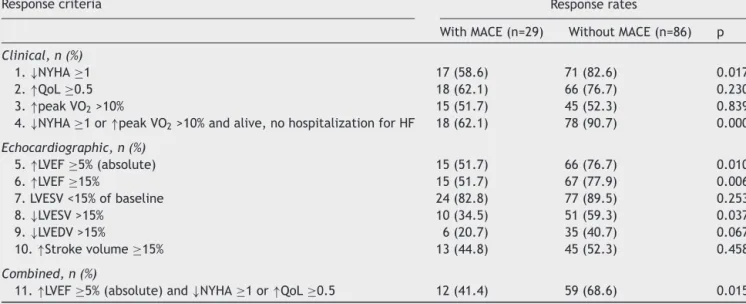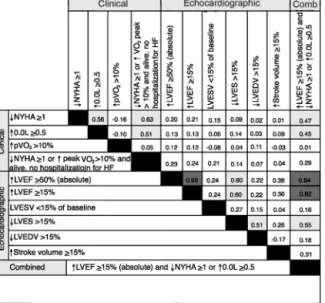www.revportcardiol.org
Revista
Portuguesa
de
Cardiologia
Portuguese
Journal
of
Cardiology
ORIGINAL
ARTICLE
Impact
on
long-term
cardiovascular
outcomes
of
different
cardiac
resynchronization
therapy
response
criteria
Inês
Rodrigues
a,∗,
Ana
Abreu
a,
Mário
Oliveira
a,
Pedro
S.
Cunha
a,
Helena
Santa
Clara
b,
Paulo
Osório
a,
Ana
Lousinha
a,
Bruno
Valente
a,
Guilherme
Portugal
a,
Pedro
Rio
a,
Luís
A.
Morais
a,
Vanessa
Santos
b,
Miguel
M.
Carmo
a,
Rui
C.
Ferreira
aaCardiologyDepartment,HospitaldeSantaMarta,CentroHospitalardeLisboaCentral,Lisbon,Portugal bExerciseandHealthLaboratory,CIPER,FacultyofHumanKinetics,UniversityofLisbon,Lisbon,Portugal
Received29October2017;accepted18February2018 Availableonline10December2018
KEYWORDS Cardiac resynchronization therapy; Heartfailure; Predictorsofevents; Responsecriteria Abstract
Introduction:Thereisalackofconsensusonthedefinitionofresponsetocardiac resynchro-nizationtherapy(CRT),anditisnotclearwhichresponsecriteriahavemostinfluenceoncardiac event-freesurvival.
Objectives: Toassessthepredictivevalueofvariousresponsecriteriainpatientsundergoing CRTandtheagreementbetweenthem.
Methods:We performed asecondary analysisofthe BETTER-HFtrial.Patient responsewas classified at six months after CRT according toeleven criteria used inprevioustrials. The predictivevalueofresponsecriteriaforsurvivalfreefrommortality,cardiactransplantation andheartfailurehospitalizationwasassessedbyCoxregressionanalysis.Agreementbetween thedifferentresponsecriteriawasassessedusingCohen’skappa().
Results:A total of115patients were followed for ameanof25 months. Duringfollow-up, 15deathsoccurred(13%)and29patientshadatleastoneadversecardiacevent(25%).Only fiveoftheelevenresponsecriteriawerepredictorsofevent-freesurvival.Themostpowerful isolated clinical andechocardiographic predictors were areduction of≥1 NYHA functional class(HR0.39forresponders;95%CI0.18-0.83,p=0.014)andanincreaseofatleast15%inleft ventricular ejection fraction(HR 0.43, 95%CI 0.20-0.90,p=0.024), respectively.Agreement betweenthedifferentresponsecriteriawaspoor.
∗Correspondingauthor.
E-mailaddress:inesgoncalvesrodrigues@gmail.com(I.Rodrigues).
https://doi.org/10.1016/j.repc.2018.02.010
0870-2551/©2018SociedadePortuguesadeCardiologia.PublishedbyElsevierEspa˜na,S.L.U.ThisisanopenaccessarticleundertheCC BY-NC-NDlicense(http://creativecommons.org/licenses/by-nc-nd/4.0/).
Conclusions:Mostcurrentlyusedresponsecriteriadonotpredictclinicaloutcomesandhave pooragreement.Itisessentialtoestablishaconsensusonthedefinition ofCRTresponsein ordertostandardizestudies.
©2018SociedadePortuguesadeCardiologia.PublishedbyElsevierEspa˜na,S.L.U.Thisisan openaccessarticleundertheCCBY-NC-NDlicense(
http://creativecommons.org/licenses/by-nc-nd/4.0/). PALAVRAS-CHAVE Terapiade ressincronizac¸ão cardíaca; Insuficiência cardíaca; Preditores deeventos; Critériosderesposta
Impactodosdiferentescritériosderespostaàterapiaderessincronizac¸ão noseventoscardiovascularesalongoprazo
Resumo
Introduc¸ão:Nãoexisteconsensonadefinic¸ãoderespondedoràressincronizac¸ãocardíaca(TRC), edesconhece-sequalocritérioderespostaquepoderátermaiorinfluêncianasobrevidalivre deeventoscardíacos.
Objectivos:Avaliarovalorpreditivodevárioscritériosderespostaemdoentessubmetidosà TRC,eanalisaraconcordânciaentreeles.
Métodos: SubanálisedoensaioBETTER-HF.Osdoentesforamclassificadosaosseismesesapós TRCemrespondedores,deacordocomonzecritériosutilizadosnaliteratura.Ovalorpreditivo dosdiferentescritériosderespostaparaumasobrevidalivredemorte,transplantecardíacoe hospitalizac¸ãoporinsuficiênciacardíacafoiavaliadousandoaregressãodeCox.Aconcordância entreosdiferentescritériosfoiavaliadausandoocoeficientekdeCohen.
Resultados: 115doentesforamseguidosduranteum períodomédiode25meses. Duranteo follow-upocorreram15mortes(13%)e29doentestiveram,pelomenos,umeventocardíaco adverso(25%).Apenascincodosonzecritériosderespostaforampreditoresdesobrevidalivre deeventos.Ospreditoresclínicoseecocardiográficosisoladosmaispoderososforamareduc¸ão de,pelomenos, uma classefuncionalde NYHA (HR 0,39;IC 95% 0,18-0,83,p=0,014)e um aumentode,pelomenos,15%nafrac¸ãodeejec¸ãoventricularesquerda(FEVE)(HR0,43;IC95% 0,20-0,90,p=0,024),respetivamente.Aconcordânciaentreosdiferentescritériosderesposta foifraca.
Conclusão:Amaioriadoscritériosderespostautilizadosnãoprevêoutcomesclínicos etêm fracaconcordância.Éessencialcriarumconsensonadefinic¸ãoderespostaàTRCdeformaa uniformizarosestudos.
©2018SociedadePortuguesadeCardiologia.PublicadoporElsevierEspa˜na,S.L.U.Este ´eum artigoOpen Accesssobumalicenc¸aCCBY-NC-ND(
http://creativecommons.org/licenses/by-nc-nd/4.0/).
Introduction
Cardiac resynchronization therapy (CRT) is an approved treatmentinselectedheartfailure(HF)patients,with bene-ficialeffectsonsymptoms,cardiacremodelingandfunction, andsurvival.1---5However,thereisnoconsensusregardingthe
bestdefinitionofresponsetoCRT.Numerouscriteria, includ-ing clinical and combinedendpoints, reverse remodeling, andimprovementinleftventricularejectionfraction(LVEF), arecurrently usedin the literature todefine response to CRT,andthisisfurthercomplicatedbythepooragreement betweendifferentresponsecriteria.6
Thereareseveralissuesinvolvedintheproblemof defin-ingresponsetoCRT.HFisacomplexandprogressivedisease, anddespiteimprovementsin device-basedtreatment,the prognosis is still very poor in patients with advanced HF. Somehavequestionedwhetherabsenceofchange(i.e.no deteriorationinfunction)afterCRTshouldalsobe consid-eredaresponsetotreatment.7Furthermore,patientsand
physiciansmayhavedifferentperceptionsofthebenefitsof
CRT.8AlltheseissuesmakethedefinitionofresponsetoCRT
particularlychallenging.
Theaimof thisstudywastoassesstheimpacton out-comesof differentresponse criteriacurrentlyusedin the literature in patients undergoing CRT,and the agreement betweenthem.
Methods
StudydesignWeperformedasecondary analysisoftheBETTER-HFtrial (ClinicalTrials.govidentifierNCT02413151),9aprospective,
interventional,single-centerrandomizedclinicaltrialofthe effect of cardiac rehabilitation on clinical and echocar-diographic response in patients with HF with reduced ejectionfraction(HFrEF)treatedbyCRT.Onehundredand twenty-one adult HFrEF patients referred for CRT were prospectively enrolled between April 2011 and February
2015.PatientsunderwentbaselineassessmentbeforeCRT, including clinical parameters, laboratory tests, transtho-racic echocardiogram and cardiopulmonary exercise test (CPET),andwerereassessedatsixmonthsafterCRT.
All patients provided written informed consent before anyprocedure.Thestudywasapprovedbytheinstitutional reviewboardandethicscommittee.
Studypopulation
TheBETTER-HFtrial9includedconsecutivepatientsreferred
forCRTwithorwithoutindicationfordefibrillator implan-tation.
The inclusioncriteriawerestableHFpatientsreceiving optimalHFpharmacologictherapyforatleastthreemonths, age≥18years,LVEF<35%,QRSduration≥120ms,referral forCRTatSantaMartaHospitalaccordingtoEuropean Soci-ety of Cardiology (ESC) recommendations,10---12 and stable
conditionfor>1month(nohospitalizationforcongestiveHF, nochangeinmedication,andnochangeinNewYorkHeart Association[NYHA]functionalclass).
Exclusion criteria were residence far from the hospi-tal making frequent hospital visits difficult or impossible; incapacitating orthopedic, neurologic or other conditions precluding exercise testing; refusal to participate in the study;inabilitytosigninformedconsent;previoustreatment withanintravenousinotropicagentwithinthe30daysprior toimplantation;ordeathorCRTdeviceremovalduringthe firstsixmonths.
Datacollection
Baseline and follow-up data up to November 2015 were obtained from hospital files, systematic follow-up phone calls,andthenationalhealthdatabase,whichholds infor-mationfromnationalhealthcareproviders.
Assessment
Patient assessment included NYHA functional class at baseline and six months after CRT implantation, the HeartQoLquality-of-lifescore,13 transthoracic
echocardio-graphy(LVEF,leftventricular end-systolicvolume[LVESV], leftventricularend-diastolicvolume[LVEDV]andstroke vol-ume), CPET (peak oxygen consumption [peak VO2]), and
blood samples (serum creatinine and B-type natriuretic peptide [BNP])for a more objectivequantification of the physiologicandclinicalbenefitsofCRT.
Baselinedemographicdata(ageandgender),HFetiology, riskfactors(hypertension,hyperlipidemia,diabetes, smok-ing and obesity), medication and electrocardiogram were alsorecorded.
Theprimaryendpointwasacompositeofall-causedeath, hearttransplantationandhospitalizationforHF(unplanned hospitalizationformorethan24hourscausedbyHF decom-pensation)duringfollow-up.
Table1 Analyzedresponsecriteria. Clinical
1.↓≥1NYHAclass14---17 2.↑QoL≥0.512 3.↑peakVO2>10%18
4.↓≥1NYHAclassor↑peakVO2>10%andalive,no hospitalizationforHF17 Echocardiographic 5.↑LVEF≥5%(absolute)13,19 6.↑LVEF≥15%20,21 7.LVESV<15%ofbaseline22 8.↓LVESV>15%14,23---28 9.↓LVEDV>15%14 10.↑Strokevolume≥15%21,29,30 Combined
11.↑LVEF≥5%(absolute)and↓≥1NYHAclassor↑QoL ≥0.531
↑:higher:↓:lower;LVEDV:leftventricularend-diastolicvolume; LVEF:leftventricularejectionfraction;LVESV:leftventricular end-systolicvolume; NYHA:NewYorkHeartAssociation func-tionalclass;peakVO2:oxygenconsumptionatpeakexercise;
QoL:HeartQoLquality-of-lifescore.
Cardiacresynchronizationtherapyresponse criteria
Taking into account the seventeen different primary responsecriteriaidentifiedbyFornwaltetal.6inareviewof
the26publicationswithmostcitationsaddressingresponse to CRT, and adapting them to our routine assessment of CRTpatients,weincluded intheanalysiselevendifferent responsecriteria: fourclinical,sixechocardiographic,and onecombinedcriterion,aslistedinTable1.
Statisticalanalysis
Data analysis wasperformed using IBM SPSS® version 20. Continuousdatawereexpressedasmean±standard devia-tionandcomparedusingthenon-parametricWilcoxonrank test. Categorical data were displayed as frequencies and percentages, and compared using the chi-square test or Fisher’sexacttestasappropriate.
Responsecriteriathatwerepotentialpredictorsof sur-vivalfreefrommajoradverse cardiacevents(MACE)were assessedbyunivariateCoxregressionanalysis.Theresults are expressed as hazard ratios (HR) with 95% confidence intervals (CI). The best predictive criteria (clinical and echocardiographic)weresubsequentlycombined(apatient whohad fulfilled both response criteriawas classified as a responder) to determine whether the predictive value improvedwitheachisolatedcriterion.Thetwo-sidedlevel ofsignificancewassetatp<0.05.
Agreementbetweenthedifferentresponsecriteriawas assessedusingCohen’skappa(),rangingfrom-1(perfect disagreement)to+1(perfectagreement),with0indicating thatagreementisexactlythatexpectedbychance.32
val-ues≥0.75 wereconsideredasstrong agreement,0.4-0.75 asmoderateagreement,and≤0.4aspooragreement.33
Results
Baselinecharacteristicsandmajoradversecardiac eventsatfollow-up
Ofthe121consecutivepatientsincludedintheBETTER-HF trial,9sixwereexcludedfromthisanalysis(intwo,the
sys-temwasremoved inthefirstsixmonthsdue toinfection, twodiedbeforethesix-month reassessment,and twodid notundergothesix-monthexams).
Atotalof115patientswithadvancedHFwereincluded (73.9%inNYHAclassIII-IV),meanage68years,68%male. IschemicHFwaspresent in 37%of thepatients andatrial fibrillationin24%.MeanbaselineQRSdurationwas146ms and mean LVEF was 27%. A CRT defibrillator (CRT-D) was implantedin95patients(82.6%)andaCRTpacemaker (CRT-P)intheremaining.
Duringameanfollow-upof25±13months,atleastone MACEoccurredin29patients(25%).Fifteenpatients(13%)
died (two fromsudden cardiacdeath[SCD],10 from con-gestive HF, and three from systemic infection), 25 were hospitalizedforHF(21.7%),andone(0.8%)underwentheart transplantation. The incidence of SCD(two patients with CRT-D) was1% per year. There were nosignificant differ-encesbetweenpatientswithandwithoutMACEinmostof thebaselinecharacteristicsanalyzed,exceptforserum cre-atinineandBNPlevels,bothofwhichwerehigherinpatients with MACE (serum creatinine 1.28±0.52 mg/dl vs. 1.04± 0.39 mg/dl, p=0.007; BNP 734±683 pg/ml vs. 392±390 pg/ml,p=0.005).
The characteristics of the overall population at base-lineandaccordingtooccurrenceofMACEarepresentedin Table2.
Predictivevalueofresponsecriteria
Patients without MACE during the follow-up period were more frequently responders by all the response criteria,
Table2 Characteristicsoftheoverallpopulationatbaselineandaccordingtotheoccurrenceofmajoradversecardiacevents. Total(n=115) WithMACE(n=29) WithoutMACE(n=86) p
Male,n(%) 78(67.8) 23(79.3) 55(64.0) 0.126
Age,years 68.4±10.1 68.4±9.1 68.4±10.4 0.602
IschemicHF,n(%) 42(36.5) 12(41.4) 30(34.9) 0.530
Cardiovascularriskfactors
Hypertension,n(%) 102(88.7) 23(79.3) 79(91.9) 0.065 Hyperlipidemia,n(%) 80(69.6) 20(69.0) 60(69.8) 0.935 Diabetes,n(%) 47(40.9) 10(34.5) 37(43.0) 0.418 Smoking,n(%) 24(20.9) 9(31.0) 15(17.4) 0.119 Obesity(BMI≥30),n(%) 30(26.1) 8(27.6) 22(25.6) 0.832 Cardiovascularmedication BB,n(%) 100(87.0) 27(93.1) 73(84.9) 0.349 ACEI/ARB,n(%) 103(89.6) 26(89.7) 77(89.5) 1.000 Diuretics,n(%) 106(92.2) 28(96.6) 78(90.7) 0.445 NYHA≥III,n(%) 85(73.9) 21(72.4) 64(74.4) 0.812 QoL 0.95±0.69 1.03±0.80 0.93±0.66 0.831 Baselineelectrocardiogram QRS,ms 146±22 143±23 147±21 0.487 LBBB,n(%)(n=85) 78(91.8) 21(91.3) 57(91.9) 1.000 AF,n(%) 28(24.3) 9(31.0) 19(22.1) 0.622 Baselineechocardiogram LVEF,% 27±7 25±7 27±7 0.243 LVESV,ml 154±58 165±60 150±57 0.116 LVEDV,ml 208±71 222±69 202±72 0.109 BaselineCPET PeakVO2,ml/kg/min 14.5±5.3 15.0±5.7 13.4±4.1 0.299
Baselinebloodtests
BNP(pg/ml) 493±515 734±683 392±390 0.005
Creatinine(mg/dl) 1.10±0.44 1.28±0.52 1.04±0.39 0.007
Follow-up,months 25±13 22±12 26±13 0.189
ACEI:angiotensin-convertingenzymeinhibitor;AF:atrialfibrillation;ARB:angiotensinreceptorblocker;BB:beta-blocker;BMI:body massindex;BNP:B-typenatriureticpeptide;CPET:cardiopulmonaryexercisetesting;HF:heartfailure;LBBB:leftbundlebranchblock; LVEDV:leftventricularend-diastolicvolume;LVEF:leftventricularejectionfraction;LVESV:leftventricularend-systolicvolume;MACE: majoradversecardiacevents;NYHA:NewYorkHeartAssociationfunctionalclass;PeakVO2:oxygenconsumptionatpeakexercise;QoL: HeartQoLquality-of-lifescore.
Table3 Responseratesinpatientswithandwithoutmajoradversecardiacevents.
Responsecriteria Responserates
WithMACE(n=29) WithoutMACE(n=86) p Clinical,n(%)
1.↓NYHA≥1 17(58.6) 71(82.6) 0.017
2.↑QoL≥0.5 18(62.1) 66(76.7) 0.230
3.↑peakVO2>10% 15(51.7) 45(52.3) 0.839
4.↓NYHA≥1or↑peakVO2>10%andalive,nohospitalizationforHF 18(62.1) 78(90.7) 0.000
Echocardiographic,n(%) 5.↑LVEF≥5%(absolute) 15(51.7) 66(76.7) 0.010 6.↑LVEF≥15% 15(51.7) 67(77.9) 0.006 7.LVESV<15%ofbaseline 24(82.8) 77(89.5) 0.253 8.↓LVESV>15% 10(34.5) 51(59.3) 0.037 9.↓LVEDV>15% 6(20.7) 35(40.7) 0.067 10.↑Strokevolume≥15% 13(44.8) 45(52.3) 0.458 Combined,n(%)
11.↑LVEF≥5%(absolute)and↓NYHA≥1or↑QoL≥0.5 12(41.4) 59(68.6) 0.015
↑:higher;↓:lower;LVEDV:leftventricularend-diastolicvolume;LVEF:leftventricularejectionfraction;LVESV:leftventricular end-systolicvolume;NYHA:NewYorkHeartAssociationfunctionalclass;peakVO2:oxygenconsumptionatpeakexercise;QoL:HeartQoL quality-of-lifescore.
achievingsignificantlyhigherresponserates ontheNYHA, LVEFandLVESVcriteria(Table3).
Ofalltheresponsecriteriaanalyzed,onlyfivewere pre-dictorsofMACE.Thestrongestpredictorwasthecombined clinical criterionincludingreductionofat leastone NYHA class or >10% improvement in peak VO2 and being alive,
withnohospitalizationforHFin thefirstsixmonthsafter CRTimplantation(HR0.21;95%CI0.10-0.46,p<0.001).The moststronglypredictiveisolatedclinicalresponsecriterion wasreductionofatleastoneNYHAclass,whichwas associ-atedwith61%lowerriskforfutureMACE(HR0.39;95%CI 0.18-0.83, p=0.014).The bestechocardiographic response
criterion wasa relative increase in LVEF of at least 15%, whichwasassociatedwith57% lowerriskfor futureMACE (HR0.43,95%CI0.20-0.90,p=0.024)(Table4andFigure1). The combination of the best clinical and echocardio-graphiccriteria(reductionofatleastoneNYHAclassor>10% improvementinpeakVO2andbeingalive,withno
hospital-izationforHFinthefirstsixmonthsafterCRTimplantation, andincreaseinLVEFofatleast15%)wasmorestrongly pre-dictivethanthe echocardiographiccriterion butnotmore sothantheclinicalcriterionalone(HR0.256,95%CI 0.118-0.554,p=0.001).Thecombination of reductionofat least oneNYHA class and increase in LVEF of at least 15% was
Table4 Predictorsofmajoradversecardiacevents.
Responsecriteria Univariateanalysis
HR(95%CI) p
Clinical
1.↓NYHA≥1 0.39(0.18-0.83) 0.014
2.↑QoL≥0.5 0.57(0.22-1.44) 0.233
3.↑peakVO2>10% 0.70(0.35-2.03) 0.695
4.↓NYHA≥1or↑peakVO2>10%andalive,nohospitalizationforHF 0.21(0.10-0.46) <0.001
Echocardiographic 5.↑LVEF≥5%(absolute) 0.45(0.21-0.94) 0.033 6.↑LVEF≥15% 0.43(0.20-0.90) 0.024 7.LVESV<15%ofbaseline 0.44(0.17-1.18) 0.103 8.↓LVESV>15% 0.59(0.27-1.30) 0.190 9.↓LVEDV>15% 0.54(0.22-1.33) 0.179 10.↑Strokevolume≥15% 0.91(0.42-1.97) 0.816 Combined
11.↑LVEF≥5%(absolute)and↓NYHA≥1or↑QoL≥0.5 0.47(0.22-0.99) 0.049
LVEF:leftventricularejectionfraction;LVEDV:leftventricularend-diastolicvolume;LVESV:leftventricularend-systolicvolume;NYHA: NewYorkHeartAssociationfunctionalclass;peakVO2:oxygenconsumptionatpeakexercise;QoL:HeartQoLquality-of-lifescore.
Figure1 Survivalcurvesofcumulativeoccurrenceofmajoradversecardiaceventsinrespondersornon-responderstocardiac resynchronization therapy according to the most strongly predictive response criteria. (A) Criterion of ↓NYHA ≥1; (B) crite-rionof↓NYHA≥1 or↑peakVO2>10%andalive,nohospitalizationfor heart failure;(C)criterion of↑LVEF ≥5%(absolute); (D) criterionof↑LVEF≥15%;(E)criterionof↑LVEF≥5%(absolute)and↓NYHA≥1or↑HeartQoL≥0.5.↑:higher:↓:lower;CI: confi-denceinterval;CRT:cardiacresynchronizationtherapy;HF:heartfailure;HR:hazardratio;LVEF:leftventricularejectionfraction; NYHA:NewYorkHeartAssociationfunctionalclass;QoL:HeartQoLquality-of-lifescore.
morepredictiveofnoMACEthaneitherofthetwocriteria alone(HR0.292,95%CI0.132-0.646,p=0.002).
Agreementbetweenresponsecriteria
Agreement between the different response criteria as a group(=0.24±0.25),andalsobetweenechocardiographic response criteria and clinical criteria (=0.19±0.21 and 0.25±0.36,respectively)waspoor.Ofthetotalof55pairs analyzed, the majority (78.2%) had poor agreement, and only three (5.5%) had values in the range of strong agreement. Excluding response criteria whose definition includedmultiplevariables,andassessingtheisolated
clin-ical criteria, there was a moderate agreement between improvement in NYHA functional class and qualityof life (=0.56),butpooragreementbetweentheseandincrease in peakVO2 (=-0.16and=-0.10,respectively). Between
thesixechocardiographiccriteria,onlythreepairsachieved moderateagreement,higherLVEF/lowerLVESV(=0.60)and lowerLVEDV/higherLVESV(=0.51)(Figure2).
Discussion
While thebeneficial effects ofCRT onsymptoms, cardiac remodelingandfunction,andsurvivalhavebeenwell estab-lishedinmultipletrials,thereisstillnoconsensusregarding
Figure 2 Agreement between response criteria was strong inonly 7.6%ofresponse criteria pairs. Cohen’s valuesare color-codedaccordingtothefollowingranges:darkgray=strong agreement(≥0.75),lightgray=moderateagreement( 0.4-0.75), none=poor agreement ( ≤0.4). ↑: higher: ↓: lower; Comb:combined;HF:heartfailure;LVEDV:leftventricular end-diastolicvolume;LVEF:leftventricularejectionfraction;LVESV: left ventricular end-systolic volume; NYHA: New York Heart Associationfunctionalclass;peakVO2:oxygenconsumptionat peakexercise;QoL:HeartQoLquality-of-lifescore.
thebestdefinitionof responsetoCRT.The primaryresult ofthepresentanalysisisthatinoursampleofHFpatients treatedbyCRT,onlyaminority(fiveoutof11)ofcommonly usedcriteriaofresponsetoCRTintheliteraturepredicted MACE-freesurvival25monthsafterCRTimplantation.A pre-viousstudybyBoidoletal.,34including97patientsfollowed
foroneyear,showedsimilarfindings,withonlyeightof15 analyzed criteria differentiating patients withMACE from thosewhoremainedevent-free.Theseresultshighlightthe lackofuniformityandpredictiveabilityofthemultiple cri-teriausedintheliterature.
ThemostpowerfulisolatedpredictorsofMACEidentified wereNYHAfunctionalclassandLVEF.Patientswhofulfilled theseseparatelyhadalowerriskofmajoreventsat follow-up of 61% and57%, respectively. Similarly, Boidol et al.34
concludedthatimprovementinNYHAfunctionalclasswas the most strongly predictive clinical criterion (adjusted relativerisk[RR]4.4;p=0.002),whilethemoststrongly pre-dictiveechocardiographicresponsecriterionwasadecrease inLVESVindex(adjustedRR3.49;p=0.002).
Arecent studybyRickardetal.35 assessed
echocardio-graphic predictors of long-term survival following CRT in 436patientsfollowedfor5.4±2.3years.Variouschangesin LVESV,LVEDVandLVEFweretested.Theauthorsconcluded that LVEF improvement and LVESV reduction were similar intermsofprognosisandwerebothsuperiortodefinitions using LVEDV, as was shown in our study, in which LVEDV reductionwasalsonotapredictorofevent-freesurvival.
On the other hand, we found that combining clinical and echocardiographic parametersadds predictive power. Although the combination of criteria may hamper their
application in daily clinical practice,this could be away toimproveidentificationofpatientswhowillhaveabetter prognosis.
OurpopulationincludedpatientswithCRTdeviceswith orwithoutdefibrillator.Wedonotconsiderthisa confound-ingfactor,astheincidenceofSCDwaslow (1%peryear), andonlyoccurredintwoischemicpatientswithCRT-D.
Another finding of our study was the poor agree-ment between the response criteria analyzed as a group (=0.25),andbetweenclinicalandechocardiographic crite-ria.ThiswasalsofoundbyFornwaltetal.,6whoconcluded
thatagreementbetween differentmethods todefine CRT responsewaspoor75%ofthetimeandpointedoutthatthis severelylimitstheabilitytogeneralizeandcompareresults betweenstudies.Thisdiscrepancybetweendifferent crite-riacouldinpartbeexplainedbythedifferentaspectsofHF statusthattheyassess.36
Toourknowledge,thecurrentstudyisthelargest com-paringtheimpactonlong-termcardiaceventsofcommonly usedechocardiographic andclinical CRTresponsecriteria. Wedemonstratethatthecriteriahavepooragreementwith eachotheranddonothavethesameimpactonprognosis. Itisessentialtoestablishaconsensusonthedefinitionof CRTresponseinordertostandardizestudies.More impor-tantly,ifthereisbetterunderstandingofwhichpatientswill achievethebestresponsetoCRT,thismayleadtochanges inselectionfortreatment.
Limitations
The current study has the limitations inherent to any single-centerstudy,whichmayincludeselectionbias.Also, patients whodied within six months of CRT implantation wereexcludedfromouranalysis,andsonoconclusionscan be drawn for this specific population. Response was only assessedatsixmonthsafterCRT implantation,and there-forewecannotknowifthesameresultswouldbefoundif responsehadbeenassessedbeforeorafterthistime.
Moreover,echocardiographic responsestoCRT is inher-entlylimitedbyinter-andintraobservervariability,which isalimitationinanystudyinvolvingtheseparameters.
Arelativelimitationisthefollow-upduration.Although thiswasoneofthelongeststudiescomparingdifferent clin-icalandechocardiographicresponsecriteria,thepredictive valueofdifferentcriteriaisstillunknownintermsoftheir impactonlonger-termcardiacevents.
Conclusion
InadvancedHFpatientstreatedbyCRT,notallofthe com-monlyusedresponsecriteriapredictedoutcomes,andthere waspooragreementbetweenthem.ImprovementinNYHA functionalclassandinLVEFweretheisolatedcriteriawith themostpowerfulpredictivevalueforMACE-freesurvival. The association of these two criteriaimproved their pre-dictivevalue. Thesefindingsmaymeanthatthesecriteria aretobepreferredtootherswhendefiningCRTresponsein futurestudies.Itisessentialtoestablishaconsensusonthe definitionofCRTresponseinordertostandardizestudies.
Conflicts
of
interest
Theauthorshavenoconflictsofinteresttodeclare. Allauthorstakeresponsibilityforallaspectsofthe relia-bilityandfreedomfrombiasofthedatapresentedandtheir discussedinterpretation.
Acknowledgments
Theauthorswishtothankallthe staffof theSantaMarta Electrophysiology andPacingDepartment and Echocardio-graphicLaboratoryfortheirassistancewiththisproject.
References
1.Cazeau S,LeclercqC,Lavergne T,et al.Effects ofmultisite biventricularpacinginpatientswithheartfailureand intraven-tricularconductiondelay.NEnglJMed.2001;344:873---80. 2.AbrahamWT,FisherWG,SmithAL,etal.Cardiac
resynchroniza-tioninchronicheartfailure.NEnglJMed.2002;346:1845---53. 3.Bristow MR, Saxon LA, Boehmer E, et al.
Cardiac-resynchronization therapy with or without an implantable defibrillationinadvancedchronicheartfailure.NEnglJMed. 2004;350:2140---50.
4.ClelandJG,DaubertJC,ErdmannE,etal.Theeffectofcardiac resynchronizationonmorbidityandmortalityinheartfailure. NEnglJMed.2005;352:1539---49.
5.MossAJ,HallWJ,CannomDS,etal.Cardiac-resynchronization therapyforthepreventionofheart-failureevents.NEnglJMed. 2009;361:1329---36.
6.FornwaltBK,SpragueWW,BeDellP,etal.Agreementispoor amongcurrentcriteriausedtodefineresponsetocardiac resyn-chronizationtherapy.Circulation.2010;121:1985---91. 7.BaxJJ,GorcsanJ.EchocardiographyandnoninvasiveImaging
incardiacresynchronizationtherapy:resultsofthePROSPECT (PredictorsofResponsetoCardiacResynchronizationTherapy) StudyinPerspective.JAmCollCardiol.2009;53:1933---43. 8.AuricchioA,PrinzenFW.Non-responderstocardiac
resynchro-nizationtherapy---themagnitudeoftheproblemandtheissues. CircJ.2011;75:521---7.
9.ClinicalTrials.gov[Internet].Bethesda(MD):NationalLibraryof Medicine (US). 2000Feb 29 ---Identifier NCT02413151, Exer-ciseTraining Following CardiacResynchronizationTherapy in Patients With ChronicHeart Failure; 2015 April 9. Available from:https://clinicaltrials.gov/ct2/show/NCT02413151. 10.DicksteinK,VardasP,AuricchioA,etal.2010FocusedUpdate
ofESCGuidelinesondevicetherapyinheartfailure:anupdate ofthe2008ESCGuidelinesforthediagnosisandtreatmentof acute and chronic heart failure and the 2007 ESC guide-lines for cardiac and resynchronization therapy. Developed with the special contribution of the Heart Failure Associa-tionandtheEuropeanHeartRhythmAssociation.EurHeartJ. 2010;31:2677---87.
11.McMurrayJJ,AdamopoulosS,AnkerSD,etal.ESCGuidelines forthediagnosisandtreatmentofacuteandchronicheart fail-ure2012.TheTaskForcefor theDiagnosisandTreatmentof AcuteandChronicHeartFailure2012oftheEuropeanSociety ofCardiology.DevelopedincollaborationwiththeHeartFailure Association(HFA)oftheESC.EurHeartJ.2012;33:1787---847. 12.Brignole M, Auricchio A, Baron-Esquivias G, et al. 2013 ESC
Guidelines on cardiac pacing and cardiac resynchronization therapy.TheTaskForceoncardiacpacingandresynchronization therapyoftheEuropeanSocietyofCardiology(ESC).Developed incollaborationwiththeEuropeanHeartRhythmAssociation (EHRA).EurHeartJ.2013;34:2281---329.
13.OldridgeN,HoferS,McGeeH,etal.TheHeartQoL:PartII. Vali-dationofanewcorehealth-relatedqualityoflifequestionnaire forpatientswithischemic heartdisease.EurJPrevCardiol. 2014;21:98---106.
14.Bleeker GB, Bax JJ, Fung JWH, et al. Clinical versus echocardiographic parameters to assess response to car-diac resynchronization therapy. Am J Cardiol. 2006;97: 260---3.
15.Molhoek SG, Bax JJ, Bleever GB, et al. Comparison of responsetocardiacresynchronizationtherapyinpatientswith sinus rhythm versuschronic atrialfibrillation. Am JCardiol. 2004;94:1506---9.
16.MolhoekSG,BaxJJ,BoersmaE,etal.QRSdurationand short-eningtopredictclinicalresponsetocardiacresynchronization therapyin patientswithend-stageheartfailure. PacingClin Electrophysiol.2004;27:308---13.
17.MolhoekSG,Bax JJ,VanErvenL, et al.Comparison of ben-efitsfromcardiac resynchronizationtherapyinpatientswith ischemic cardiomyopathyversusidiopathic dilated cardiomy-opathy.AmJCardiol.2004;93:860---3.
18.Lecoq G, Leclercq C, Leray E, et al. Clinical and electro-cardiographic predictors of a positive response to cardiac resynchronizationtherapyinadvancedheartfailure.EurHeart J.2005;26:1094---100.
19.BaxJJ,MarwickTH,MolhoekSG,etal.Leftventricular dyssyn-chronypredictsbenefitofcardiacresynchronizationtherapyin patientswithend-stageheartfailurebeforepacemaker implan-tation.AmJCardiol.2003;92:1238---40.
20.GorcsanJ, Tanabe M, BleekerGB, et al. Combined longitu-dinal and radial dyssynchrony predicts ventricular response afterresynchronizationtherapy. J AmCollCardiol. 2007;50: 1476---83.
21.Suffoletto MS, Dohi K, Cannesson M, et al. Novel speckle-trackingradial strain from routine black-and-white echocar-diographic images to quantify dyssynchrony and predict response to cardiac resynchronization therapy. Circulation. 2006;113:960---8.
22.StellbrinkC,BreithardtOA,FrankeA,etal.Impactofcardiac resynchronization therapy using hemodynamically optimized pacingonleftventricularremodelinginpatientswith conges-tiveheartfailureandventricularconductiondisturbances.JAm CollCardiol.2001;38:1957---65.
23.NotarbartoloD,MerllinoJD,SmithAL,etal.Usefulnessofthe peakvelocitydifferencebytissueDopplerimagingtechniqueas aneffectivepredictorofresponsetocardiacresynchronization therapy.AmJCardiol.2004;94:817---20.
24.Chung ES, Leon AR, Tavazzi L, et al. Results of the Pre-dictors of Response to CRT (PROSPECT) trial. Circulation. 2008;117:2608---16.
25.Yu CM, Chan YS, ZhangQ, et al. Benefits of cardiac resyn-chronizationtherapyforheartfailurepatientswithnarrowQRS complexesandcoexistingsystolicasynchronyby echocardiog-raphy.JAmCollCardiol.2006;48:2251---7.
26.Yu CM, Fung JWH, Chan YS, et al. Comparison of efficacy ofreverseremodelingandclinicalimprovementforrelatively narrowandwide QRScomplexesaftercardiac resynchroniza-tion therapy for heart failure. J Cardiovasc Electrophysiol. 2004;15:1058---65.
27.Yu CM, Zhang Q, Chan YS, et al. TissueDoppler velocity is superiortodisplacementandstrainmappinginpredictingleft ventricularreverseremodellingresponseaftercardiac resyn-chronizationtherapy.Heart.2006;92:1452---6.
28.Yu CM, Zhang Q, Fung JWH, et al. A novel tool to assess systolicasynchrony and identifyresponders ofcardiac resyn-chronizationtherapybytissuesynchronizationimaging.JAm CollCardiol.2005;45:677---84.
29.DohiK,SuffolettoMS,SchwartzmanD,etal.Utilityof echocar-diographic radial strain imaging to quantify left ventricular
dyssynchronyandpredictacuteresponsetocardiac resynchro-nizationtherapy.AmJCardiol.2005;96:112---6.
30.GorcsanJ,KanzakiH, BazazR,et al.Usefulnessof echocar-diographic tissue synchronization imaging to predict acute responsetocardiacresynchronizationtherapy.AmJCardiol. 2004;93:1178---81.
31.WhiteJA,YeeR,YuanXP,etal.Delayedenhancementmagnetic resonanceimagingpredictsresponsetocardiac resynchroniza-tion therapy in patients with intraventricular dyssynchrony. JAmCollCariol.2006;48:1953---60.
32.HulleySB,CummingsSR,BrownerWS,etal.Designingclinical research:anepidemiologicapproach.2nded.Philadelphia,PA: LippincottWilliams&Wilkins;2001.
33.FleissJL.Statisticalmethodsforratesandproportions.2nded. NewYork:JohnWiley&Sons;1981.
34.BoidolJ,SredniawaB,KowalskiO,etal.Manyresponsecriteria arepoorpredictors ofoutcomes aftercardiac resynchroniza-tiontherapy:validationusingdatafromtherandomizedtrial. Europace.2013;15:835---44.
35.RickardJ,BaranowskiB, WilsonTangWH,et al. Echocardio-graphicpredictorsoflong-termsurvivalinpatientsundergoing cardiacresynchronizationtherapy:whatistheoptimalmetric? JCardiovascElectrophysiol.2017;28:410---5.
36.European Heart Rhythm Association (EHRA); European Soci-etyofCardiology(ESC); HeartRhythmSociety;HeartFailure Society ofAmerica (HFSA); American Societyof Echocardio-graphy (ASE); American Heart Association (AHA); European Association of Echocardiography(EAE) ofESC; Heart Failure Association of ESC (HFA)Daubert JC, Saxon L, Adamson PB, et al. 2012 EHRA/HRS expert consensus statement on car-diac resynchronization therapy inheart failure:implant and follow-uprecommendationsandmanagement.HeartRhythm. 2012;9:1525---76.




